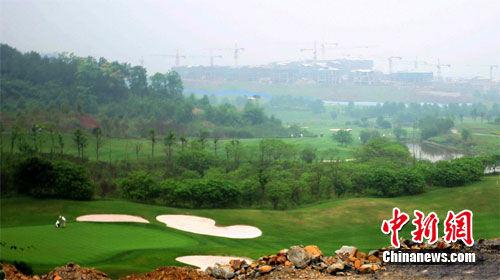(Ecns.cn) – Banned in the mid-1980s for being too bourgeois, Golf has a relatively short history in China, and for decades the sport experienced a variety of twists and turns before its recent prevalence in the country.
World-famous golfer Tiger Woods once said that golf is truly an international affair. And now that the IOC has finally approved golf for inclusion in the 2016 Rio de Janeiro Olympics, the number of players is expected to keep growing, according to the China Golf Association.
Yet golf is often vexed by negative connotations when it catches on in developing countries such as China and Vietnam, where it is often closely connected with corruption and wasted resources.
Sport for the rich
Currently golf is one of China's fastest growing industries, and the number of golf courses in the country has more than tripled since 2004, according to China Daily. Most of these courses are concentrated in the wealthy or temperate eastern and southern provinces, such as Beijing, Jiangsu, Guangdong and Hainan.
Lu Yuanzhen, a professor from the Department of Physical Education at South China Normal University, said the number of people who welcome the sport is roughly equal to those who resist it, and that many of the devoted followers are celebrities, corporate executives, businessmen and government officials.
The coming of golf has brought culture shock to many Chinese and resulted in some ideological resistance, but with time it has gradually become accepted in some communities. But the sport has also been blamed as part of the decay of society, added Lu.
According to Mr. Sun, a staff member working at a golf club in south China's Guangdong Province, more than 70 percent of players go to golf courses to discuss business matters, because they think the environment there will calm them and help conversations flow smoothly.
Mr. Fang from Beijing also thinks that golf is like the popular game Mahjong, which can help nurture relationships between possible partners. Golf has already become an important tool to facilitate business, he said.
David Chu, developer of Mission Hills Golf Club, revealed that golf was a new phenomenon in China only ten years ago, but that now the trend cannot be stopped. There is no reason to worry much because people's incomes are growing very fast, Chu added, and he is betting that size matters when it comes to attracting China's new rich.
However, when golf is taken advantage of for commercial interests and "players" like it mostly because it can lead to greater wealth, the genuine nature of the sport will definitely be affected. If this is true, then China's golf industry may be headed for the same fate as Japan's.
Vanishing land and water resources
Though the government has officially banned the construction of new golf courses, clever developers have found loopholes in the law allowing them to build "country clubs" rather than golf courses, which are in fact the same thing.
In 2004, before the State Council issued the ban, there were only about 170 golf courses in China. This year the number has risen to over 600, not including those under construction. The "golf boom" is very much underway, and hundreds more are scheduled to be opened in the next few years.
In China's tropical island province of Hainan, which the government guarantees will be a "top international tourism destination" by 2020, golf is set to become a major attraction. It is expected that between 100 and 300 courses will be built in the province; the most audacious project so far is the latest offering from Hong Kong's Mission Hills Group, which plans to build the world's largest golf facility in Hainan, with some 22 courses.
In Beijing, there are currently at least 75 golf courses, covering a total area of 132,257.75 mu (8,817 hectares), about 12 percent of downtown Beijing. According to a report cited by China Youth, a standard golf course with 18 holes uses about 2,000 to 2,500 cubic meters of water a day, which means Beijing's golf courses alone use up to 60 million cubic meters of water every year.
In West China, golf course construction has also just seen an upsurge. In Yulin city of Shaanxi Province, a large golf course project will sacrifice 4,000 mu (267 hectare) of land for golf, which has been acquired free of charge, reported Xinhua.
The "small white ball" flies and rolls happily on the ground in China, but it also results in a massive waste of resources that the country needs most, commented a resident in Guangdong.
Minority or Majority?
Many say golf is a noble sport, but in China the average initial membership fees are in the tens of thousands of yuan – sometimes in the millions – which is about four to five times as much in the West. Meanwhile, the country is estimated to have less than 3 million people who play golf. Though more Chinese will surely take to the fairways as incomes rise, the rate is still relatively low.
A lack of political support is also an obstacle for development. If 3 million Chinese are golfing, that means 1.297 billion are not, and the fact is that only a handful of professional Chinese golfers actually earn a living from the game.
This is currently a problem. The government may need to consider changing its attitude towards golf and shift it from a sport for the minority to one for the majority, which may also help professional players reach the forefront of the international golfing world.


















